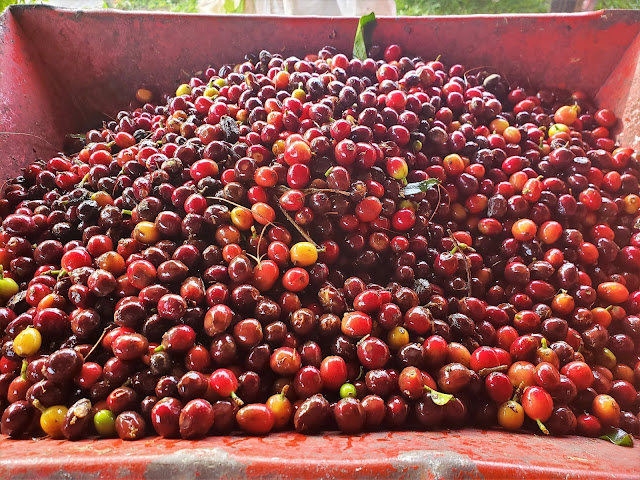Sustainable Coffee
Most people
love coffee and it has become part of our everyday routine. Whether you drink it in the early morning,
breakfast, lunch, or afternoon (or all of the above – maybe I drink too much!?),
it is an essential part of our day.
Two months ago, we had the opportunity
to pick coffee for ourselves. A friend
of ours has a farm that he let the forest take over and the coffee plants grow
wild. You won’t find this growing
technique in any manual and it’s far from the best way of mass production, but doesn’t
do it for that. Each year he picks
enough of this jungle grown organic coffee to cover his coffee consumption that
year and leaves the rest for us.
So, swinging our baskets around
our waists, we trudged up the mountain and into the forest to harvest as much
coffee as we could. Coffee plants only
produce cherries on new growth, and these plants having been let go, meant that
the new growth was high in the air. Each
plant had to be pulled down with one hand as we picked the cherries off with
the other.
After two days of picking, we
had hauled in about 200 lbs of coffee cherries.
Not bad for most of the group having no experience in picking
coffee. All of these coffee cherries
then had to be processed. To do this we
took all of the cherries to a mill, where the beans were extracted from the
fruit. At this point the fruit and skin
is usually discarded, but I had another purpose for them. We had decided that we would take the most
sustainable action we could with these coffee cherries and use every part of
them for some sort of production.
The beans were the easiest; you
make coffee with those. Ours were laid out
in our dry room to dry out. The plan was
that these would then be roasted and ground for coffee.
The skins, meant for tea. We had heard of others doing this before, so
it was not really an out of the box idea.
Our cherry skins, like the beans, were laid out to dry. After a few days, we had a feed sack full of
dry coffee cherry skins to steep in hot water for tea.
The most ambitious of our endeavors
was making wine from the fruit. I had the
experience; I’ve brewed many different types of beer in the States and
different variations of mead (honey wine) in Madagascar, but this, as far as I
could find out, had not been done. So, I
created two batches, one by washing the fruit from the beans and one from
washing the fruit from the skins. The fermentation
process started quickly, but, due to bad timing and equipment, the wine didn’t
turn out. Maybe next year!
Most
of us drink coffee every day, but most of us have no idea where that coffee
comes from. We have no idea how it is
picked, how it is processed, or the many ways in which the fruit as a whole can
be used. Every piece has a purpose; we
just sometimes need to think outside the box.











Comments
Post a Comment